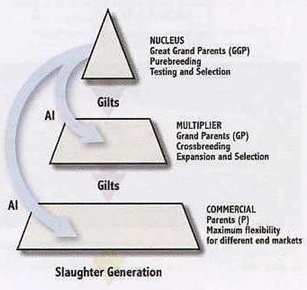Understanding the Lag of Genetic Improvement Transfer from Nucleus to Commercial Units
Dr. Pius B. Mwansa, Genesus Geneticist
The pig industry’s production system or pork value chain is usually viewed as a three-tiered pyramid (Figure 1). This pyramid is comprised of nucleus units (selection herds), multiplier units and commercial units. Size-wise, the nucleus herds tend to be smaller than the other two components and the commercial units are the largest entities in this organizational structure. Notably, there are differences related to the synergies between the tiers from one breeding company to another. At Genesus the transfer of genetics through this pyramid and the vertical control over the components of the pyramid have been explained in a previous technical report (http://www.genesus.com/global-tech-report/transferring-genetic-improvement). In this article, the focus is on understanding additional factors that help Genesus minimize the lag observed in the transfer of genetic improvement from the nucleus to its customer’s commercial units.
 Figure 1. AI-based Genetic Improvement Pyramid (courtesy of www.britishpigs.org.uk )
Figure 1. AI-based Genetic Improvement Pyramid (courtesy of www.britishpigs.org.uk )
The degree to which each component tier is genetically behind the one just before it has been termed the genetic improvement lag (Bichard, 1971). The size of these lags, if not addressed can be substantial. Bichard (1971) observed that the annual or generational genetic progress and the age structures of the lower (multiplier and commercial) tiers are some of the factors that influence the size of the genetic lag observed in genetic improvement pyramids. Genetic improvement generated in the nucleus is additive and therefore cumulative. Thus, progressive breeding companies focus their R&D dollars on methods and technologies to create and provide genetically elite breeding stock for the multiplier units that create large volumes of improved dams for use by commercial producers. The idea is to get the elite genetics from the nucleus to the commercial units in the shortest possible time.
The fuel for genetic improvement is largely provided by the existing variation of the trait(s) of interest in the nucleus population. It is well known that this variation can be explained by genetic and environmental factors as shown in the following simple equation;
Phenotypic variance = Genotypic variance + Environmental variance.
In other words, the observed variation of the trait(s) of interest in the population is influenced by genetic and environmental factors in its simplest form. This reality, leads to an intuitive conclusion that traits with higher genetic relative to environmental variances are desirable. The industry uses the term “heritability” to represent the proportion (percent) of the total phenotypic variance explained by additive genetic effects. Other factors such as selection differential and generation interval contribute to improving the rate of genetic change. A higher rate of genetic change/progress achieved in the nucleus units will reduce the size of the genetic lag in any pyramid in use by the breeding company. See (1995) simplified and explained that genetic lag is determined by a) the number of steps involved in the breeding system (nucleus, multiplier and commercial units) – the fewer the less the experienced lag, b) the relative genetic superiority of boars and gilts transferred to multiplier and commercial tiers and c) the length of time that animals are used in lower tiers.
Genesus uses state-of-the-art genetic evaluation and selection tools that enhance genetic progress in its nucleus units. These focus on high-accuracy genetic evaluation animal-model approaches. The incorporation of genomic genetic evaluation approaches to existing pedigree-based estimated breeding values (EBVs) improve EBV accuracies and reduce generation intervals, thereby leading to reduced genetic lag of elite Genesus genetics reaching its customers. Genesus’ testing of large numbers of boars at the nucleus level in the pyramid allows the use of semen or boars direct from the nucleus in the multipliers and commercial units and this further reduces genetic lag. The ability of Genesus to have significant input in the management of breeding stock in participating multiplier and commercial herds provides Genesus with a better handle on data collection and performance-testing standards. Improved accuracy of evaluation and selection are substantial players in reducing the size of genetic lag in the industry’s pyramid. The focus Genesus puts on reducing genetic lag ensures that customers receive the most improved genetics in as short a time as possible thereby directly contributing to the profitability of their units.
References
Bichard, M. 1971. Dissemination of genetic improvement through a livestock industry. Anim. Prod. 13:4001-411
See, M. T. 1995. What the commercial producer needs to know about genetic improvement. Animal Science Facts, North Carolina State University, ANS02-820S.
Categorised in: Global Tech
This post was written by Genesus




